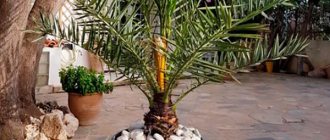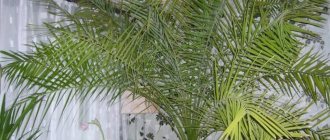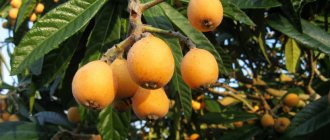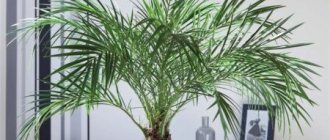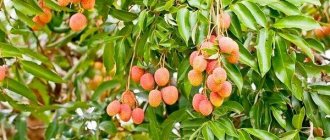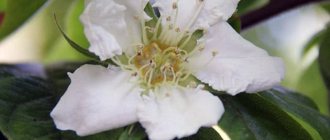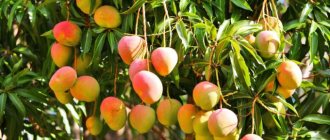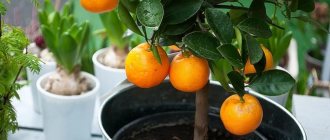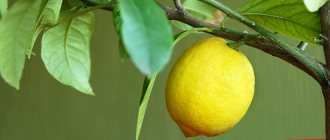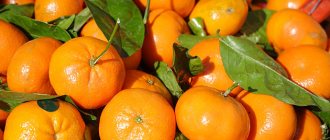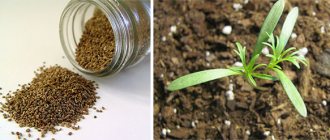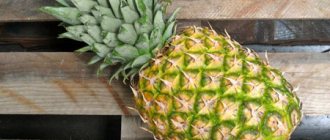How and where do dates grow?
The date tree owes its poetic name “Phoenix” (translated from Latin as “palm tree”) to Carl Linnaeus, a Swedish botanist. It is no coincidence that culture resembles the image of a mythological bird reborn from the ashes.
The photo shows how dates grow in natural conditions.
And there is something symbolic in this comparison, because the palm tree really grows from the hot desert sands, withstanding high temperatures, sandstorms, minimal rainfall, and frequent dry winds.
Under natural conditions, young plants are trees with chaotically arranged leaves, forming almost impenetrable thickets. The cells wait out the heat that comes during the day, at their only point of growth, which is located at the top of the trunk, as if plunging into a kind of suspended animation.
The culture develops and grows only at night, when the temperature drops to low levels. The productive life span of the tree is about 150–200 years; the height of an adult crop reaches about 20–40 m.
The Mediterranean coast of Africa, the Arabian Peninsula, the Middle East, and the Canary Islands are considered the birthplace of the date palm.
As a result of breeding work, the range of the palm tree has expanded significantly, and the industrial scale of tree cultivation has spread to Israel, Australia, Pakistan, Iran, Latin, Central America and the south of the country. But in Europe, the only country where the date tree regularly gifts residents with its tasty harvest is Spain.
Growing this most valuable plant in open ground in Russia is not possible due to the unsuitable climate for cultivating the tree. However, in indoor conditions, the palm tree is maintained and develops quite successfully, representing an element of spectacular, sophisticated interior decor.
Flowering and pollination
Date palms live in harems because they are dioecious. Inflorescences grow from the bases of the leaves. On some palm trees they are female, on others they are male. These inflorescences are very large, panicle-like. To ensure cross-pollination of flowers, one male tree is planted for every 20-100 female trees. Paniculate inflorescences consist of small yellow flowers. The flower has a goblet-shaped cup and 3 petals. Male flowers have 6 stamens, female flowers have 3 pistils and 6 stamidoniums. Only one pistil produces fruit after dusting.
The inflorescences contain many flowers. On one palm tree you can count up to 2000 of them. Fruits develop only in female inflorescences. Today, dates of noble varieties are obtained by artificial pollination or post-pollination of female inflorescences. To do this, the male inflorescences are cut off, and the pollen from them is shaken off over the flowering female panicles. Another option for artificial pollination is possible, when the male panicle is suspended in the crown of the female inflorescences. Next you will learn not only where dates grow on the tree, but also about their beneficial qualities.
Types of dates that can be grown from seeds
Dates grow on trees (photos of the crop clearly demonstrate its external diversity), ripening for about 8–10 months. According to available data, there are up to 17 types of crops and over 1000 varieties of palm trees bred as a result of breeding work in the world.
It is unlikely that you will be able to get a fruit-bearing tree at home, and even if the berries do appear, they will not be complete. However, decorating an apartment with a lush palm tree is a doable task.
The table shows the types of plants from the seeds of which it is possible to grow an ornamental tree in an apartment:
| Name of varieties | a brief description of |
| Robelena (Phoenix roebeienii) | This miniature date is nicknamed “dwarf” due to its short growth (reaches about 2–3 m). The plant has a thin straight trunk, slightly bumpy below. Openwork dark green with a silver tint, soft foliage is collected in a bunch at the top of the tree. Timidum blooms with yellow buds, and the fruits that appear, although edible, are very tiny - up to 2 mm. The culture is ideal for indoor growing, but requires abundant watering, intense lighting and high humidity. |
| Canary (Ph. canariensis) | A fairly large indoor palm tree is named after the islands of the same name, where it grows in rocky areas. The height of the tree can reach 18 m, the width of the trunk is 1 m. The complex pinnate greenish-gray leaves are divided into approximately 80–100 pieces. narrow and very hard plates. The female (yellow-orange) and male (cream) flowers are collected in large axillary inflorescences. The culture loves bright and well-ventilated rooms. |
| Palmate (Ph. dactvlifera) | This palm tree grows in height up to 15–26, and sometimes up to 30 m. The tree has large leaves, about 6 m long, which crown the top of the plant in the form of a bunch. The buds are collected in paniculate inflorescences. The fruits of the crop are elongated drupes (8 cm) approximately 4 cm wide. |
| Curved (Ph. reclinata) | A feature of the presented palm tree is the presence of several trunks with a total width in diameter of up to 10–17 m. The spreading leaves are shaped like bird wings. The culture, which is more reminiscent of a bush, is quite resistant to sunlight and responds well to frequent irrigation and moist air. |
| Rocky (Ph. rupicola) | A fairly frost-resistant single-stem plant with few, small leaves. The Kamenisty variety has much fewer thorns characteristic of this crop than its “relatives”. The tree reaches a height of 7–8 m. |
Date palms grown at home make this crop an original element when decorating large rooms, lobbies or hallways. Ornamental plants are successfully used in zoning indoor spaces.
Varieties of dates
The degree of maturity, moisture content and taste are the main indicators of the differences between dates among varieties. The most famous, most often found on the shelves of our stores, are about two dozen varieties.
Soft varieties
Mazafati is the main variety supplied from Iran. Mazfati dates are barrel-shaped, 2.5 to 4.5 cm in size, chocolate brown to black-brown in color, have a soft, fleshy texture and caramel flavor. Can be stored in the refrigerator for up to a year.
Kabkab are large dates, oblong-oval in shape with a small pit, the weight of 1 fruit reaches 15 grams. The color is amber-brown, they have a taste of honey, which is why they are called “honey dates”. They can be stored in the refrigerator for one and a half years, at room temperature - 6 months. are supplied mainly from Iran.
Khasoei - round, fleshy, soft dates. The color ranges from light brown to dark purple depending on where it grows. The sweetness is the same as the Kabkab variety. Hasui dates can be stored in the refrigerator for up to a year.
Barhi are round dates, slightly larger than a walnut, with juicy, aromatic and very sweet pulp. The color is yellow-caramel, the skin is separated from the pulp. Barhi dates got their name from the hot Arabian wind Barh. Barkhas are usually eaten fresh. When dried, they exhibit the aroma of vanilla and lemon balm. Supplied from Israel and Saudi Arabia. Barkhas have high humidity and can be stored in the refrigerator for up to six months. Fresh marigolds have a bright yellow color, which is why they are called “date sun”.
Anbarah is the largest date variety grown in Saudi Arabia. The fruits of these dates are oblong, red-brown, with a small stone, 2.5–3 cm in diameter, soft and sweet. The cultivation of this variety is limited and therefore they are quite expensive. Anbara is considered one of the elite varieties of dates.
Khadrawi - dates supplied from Iraq. The fruits are medium-sized, oval, aromatic with a caramel-sweet taste. The moisture content is high and therefore they are well suited for making purees and smoothies. Can only be stored in the refrigerator for up to 6 months.
Medjoul dates are from Morocco and are also grown in Israel and California. Large up to 8 cm in length, dark brown with thin skin, caramel aroma, soft and sweet. Majhul is considered the king of dates.
Hiyani dates are native to Egypt and are also grown in Israel. The fruits are brown, cylindrical in shape, up to 5 cm in size, soft, sweet and aromatic. Hiyani dates are served fresh or frozen, long-lasting.
Semi-soft varieties
Sayer or Estemra (Sayer) - grown in Iran and Iraq. One of the main varieties exported by Iran. The fruits are dark, orange-brown, oblong, medium in size. The pulp is tender, sweet and aromatic, the stone is easily separated. Keeps in the refrigerator for about a year.
Rabi is an early variety grown in Iran. The fruits are large, fleshy, dark brown in color, sweet, medium juicy, with thin skin. They are mostly used in the food industry, they are used to make marshmallows, syrup, sugar, drinks, for the preparation of oriental sweets, and added to baked goods. Stores in the refrigerator for up to a year.
Deglet Nour is a “nutmeg date” originally from Tunisia. It is considered the best of the semi-soft varieties. The most common export type, up to 50% of world trade. The fruits are elongated, 5–6 cm in size, translucent, honey-colored, the stone is visible through the light. The pulp has a dense consistency and is used for making desserts and baking.
Khudri is a variety from Saudi Arabia. The fruits are burgundy-brown, medium-sized, oval, fleshy. The skin is wrinkled, sometimes lagging behind the pulp. Khudri dates are reminiscent of toffee, sweet and can be chewed for a long time, an excellent addition to tea. Khudris quickly satisfy your hunger. Suitable for stuffing and home cooking.
Safawi is one of the best varieties of Medina. The fruits are large, up to 9 cm in length, brown-red in color, fleshy and moderately sweet, they can be chewed for a long time like caramel. Safavi dates are similar in taste to the elite Ajwa variety, but much lower in price. They are also used in the fight against helminths.
Sukkari are dates from Saudi Arabia. The fruits are small, cone-shaped, dark yellow in color, soft, aromatic, with a sweet dessert taste. Sukkari is often recommended to prevent tooth decay, reduce cholesterol levels and general fatigue.
Halawy is one of the best varieties of Iraq, translated as “sweet”. The fruits are medium-sized, elongated, oval, with thin shiny skin, color from amber to light brown. The pulp is of moderate density and is used for salads, stuffing and baking. The texture is similar to Deglet Nur. Recommended for diabetes and as supplementary nutrition for athletes.
Ajwa - dark, almost black dates, the most popular variety among Muslims. It is believed that eating Azhwa is prescribed by the Koran, where they are referred to as “Ajwa Dates from Paradise”. Azhwa is a medium-bearing variety that is why it is quite expensive. The fruits are dark chestnut in color, quite hard on the outside, but the core remains soft and tender. Due to their high price, they are often replaced with similar ones on sale; real ajavas can be distinguished by thin white lines on the peel.
Sagai are unusual two-color dates native to Saudi Arabia. The fruits are medium sized, oblong, oval. The color is light brown, the upper part is yellow. The skin is dry, wrinkled, the flesh is soft with a pleasant, gently sweet taste. Otherwise called milk dates because they are often consumed with milk. It is believed to be useful for the prevention of bone diseases.
Khalas are medium-sized fruits with translucent golden-brown skin. They have a delicate, moderately sweet caramel taste. It is customary for Arabs to consume khalas as a dessert with coffee. Can be stored at normal room temperature for about 6 months.
Durum varieties
Toory is a famous dry variety from Algeria, where it is called the “bread date”. Fruits with hard skin and dry pulp. Convenient on the go, while walking or playing sports. You can simply put a handful in your pocket and eat it when you get hungry or tired. When soaked, it is used for baking. Turi is one of the ancient varieties, the very first ones that people used for food. Can be stored for years.
Zahedi is an Iranian variety that means “Noble”. Large, hard, yellow-brown, oval-shaped fruits up to 8 cm in size with a large stone that is easily separated from the pulp. They have a pleasant sweet nutty taste. It is combined with other varieties of dates, used in baked goods and in salads, and date honey is made from zahedi. Zahedi is one of the most popular varieties in Iran and Iraq.
Selection and preparation of seeds
Dates grow on trees (photos of high-quality fruits will help you choose good planting material), like huge bunches of grapes. Growing a palm tree in an apartment is not particularly difficult, but it will look somewhat different than in natural conditions.
Initially, you need to correctly select and prepare the seeds, proceeding in the following order:
- Dates that have not been subjected to heat treatment and are within their expiration date are suitable for planting. Dried or dried berries would be a good material.
- First, you need to select at least 10 fruits and remove damaged or moldy specimens.
- Then you need to leave the pulp-free seeds in a thermos with warm drinking water for 48 hours to rid the future plant of microorganisms. The fluid needs to be changed 2-3 times a day.
- When the specified time has passed, the planting material must be washed again, then dried for 24 hours.
- Date pits have a very dense shell. To help the swollen seeds crack faster and release the root, it is recommended to slightly break the integrity of the seeds. To do this, you can carefully file (cut with a knife) their walls or pierce them in several places with a needle.
- Now you have to wrap the processed blanks in damp cotton wool or fabric, creating a kind of cocoon. In this state, the seeds should be kept for several days in a plastic container at a temperature of 20–30 °C. The packaging must be moistened periodically. You need to keep the seeds in such conditions until they hatch.
Some gardeners, without waiting for the sprouts to appear, place the treated seeds in pre-moistened soil and cover the container, thus creating a greenhouse effect inside the container.
Composition and calorie content
The calories in dried dates should not be compared to the same amount of fresh fruit. 100 grams of fresh dates contain 142 kilocalories, and the energy value of the dried product is much more than 277 kcal.
A dry product will always have more calories.
Dried fruit is dehydrated, so it is a concentration of both energy (calories) and nutrients.
The two most popular varieties of dates, Deglet Noor and Medjool, differ slightly in their nutritional content. Both varieties are a good source of vitamins and minerals.
| Vitamins | ||
| Deglet Nur | Medjool | |
| Vitamin C | 0.4 mg | 0 mg |
| Thiamine | 0.052 mg | 0.050 mg |
| Riboflavin | 0.066 mg | 0.060 mg |
| Niacin | 1.274 mg | 1.610 mg |
| Vitamin B6 | 0.165 mg | 0.249 mg |
| Folic acid | 19 mcg | 15 mcg |
| Vitamin A | 10 IU | 149 IU |
| Vitamin E | 0.05 mg | 0 mg |
| Vitamin K | 2.7 mcg | 2.7 mcg |
| Minerals | ||
| Deglet Nur (in mg) | Medjool (in mg) | |
| Calcium | 39 | 64 |
| Iron | 1,02 | 0,90 |
| Magnesium | 43 | 54 |
| Phosphorus | 62 | 62 |
| Potassium | 656 | 696 |
| Sodium | 2 | 1 |
| Zinc | 0,29 | 0,44 |
- Potassium: affects blood pressure and regulates heart function, is involved in protein synthesis, supports the nervous system and muscles;
- Magnesium: is necessary not only for the functioning of the heart and nerves, but also for basic energy transformations in our body;
- Phosphorus: responsible for the skeleton and nervous system;
- Zinc: strengthens the body's resistance to infections, maintains healthy hair and nails;
- Iron: directly affects the ability of blood to carry oxygen, also has a beneficial effect on the immune and nervous systems;
- B vitamins: are critical for the nervous system and metabolism.
Nutritional value of fresh dates (per 100 g) (for popular varieties Deglet Nur and Medjool):
| Deglet Nur | Medjool | |
| Energy | 282 kcal | 277 kcal |
| Squirrels | 2.45 g | 1.8 g |
| Fats | 0.39 g | 0.15 g |
| Carbohydrates | 75.03 g | 74.97 g |
| incl. monosaccharides | 63.35 g | 66.47 g |
| Cellulose | 8 g | 6.7 g |
Dried dates have similar nutritional value. The exception is the fiber content, which is slightly higher (about 8.7 g/100 g) than the raw fruit.
Planting a seed
When planting seeds, you must perform the following algorithm of actions:
- first you need to prepare a deep and narrow box or small plastic cups;
- to prevent moisture stagnation, it is necessary to add a 2-centimeter layer of drainage consisting of charcoal, expanded clay, broken brick or pebbles to the bottom of the container;
- then you need to put ready-made or home-made soil suitable for planting seeds in a container, consisting, for example, of a mixture of sawdust, peat, sand and humus;
- Date seeds should be planted vertically to a depth equal to 1.5 times the length of the seed. Moreover, it is important not to confuse it by placing the seeds with the blunt part facing down with the sharp end sticking out of the ground;
- Next, the planting needs to be covered with soil and lightly watered;
- the box with the prepared seeds should be left in a warm place, after which the soil will need to be sprayed periodically, preventing both the soil from drying out and becoming waterlogged.
It is recommended to cover the planted seeds with glass or film, not forgetting to ventilate the planting twice a day to eliminate excess condensation.
Planting a sprouted seedling
When using fresh and high-quality seeds, the first shoots will appear in about 1–2 months. Young dates are strikingly different from seedlings of other plants - they look more like green, very sharp skewers.
When the seedlings grow up to 10 cm long, they have to be picked. But experienced flower growers advise doing this work after the sprouts have emerged and look like white sticks.
In this case, the plant will be more actively accepted; within a year it will produce 2–3 short and wide leaf blades, while a 10-centimeter sprout will produce a seedling with 1–2 narrow, reed-like leaves.
It is necessary to plant sprouted seeds taking into account the following rules:
- For each sprout you need to choose a separate deep pot, so that later the plant can be easily and painlessly replanted. It should be remembered that dates have a very powerful root system, which requires adequate space.
- At the bottom of the container it is necessary to add a layer of drainage made of charcoal and expanded clay. And also when planting a seedling, it is recommended to use soil in which the seeds have sprouted.
- The substrate for palm trees can be taken as standard, consisting of 1 part of soil (clay/turf/leaf) and humus, as well as ½ amount of peat and coarse sand.
- The sprouted seedling should be planted together with the mother seed, which will provide the new plant with the nutrition it needs for good development.
- This procedure must be carried out with all precautions - any damage to the roots is detrimental to the crop. It is best to use the most gentle transshipment method.
Dates do not tolerate transplantation well, so this should be done annually in spring for a young tree up to 3–5 years of age, then once every 2 years. It is not advisable to disturb adult plants, limiting yourself to replacing the top layer of the formed earthen coma.
Contraindications for eating dates
Despite the abundance of beneficial properties, not everyone can eat dates. Dates are contraindicated for diabetes (1-2 dates are allowed at a time, combining them with protein foods) and individual intolerance. People suffering from stomach ulcers, gastritis, colitis, enteritis and other diseases of the digestive system should limit their consumption of fruits.
Conditions for growing date palms
A tree grown at home has advantages over a plant bought in a store - an indoor plant gets used to the created climate, lighting and care characteristics, therefore, unlike a ready-made specimen, it does not “be capricious”, gets sick less, and develops well.
Temperature and lighting
Dates, which naturally grow on trees, even in the photo seem to be bathed in the rays of the hot southern sun. A palm tree grown indoors also needs plenty of light and warmth, and does not tolerate drafts at all.
For the initial stage of growing a plant in an apartment, it is advisable to choose the most comfortable place, close to the light. An east window is best. On the south side, the crop must be protected from direct sunlight and sufficient soil moisture must be ensured.
When choosing a window sill, you need to take into account the fact that the length of the first sheet will be approximately 15 cm.
For better growth of a young seedling, it is necessary to take into account the following subtleties of cultivating a palm tree:
- The plant must be protected from direct sunlight, which can damage the leaves. The created light partial shade will help to avoid burns.
- Periodically you need to turn the pot with the tree to provide light to all its sides.
- Maintain the temperature in the room with the date no lower than +20–25 °C. In summer, with regular spraying, the plant will withstand temperatures of +30 °C. The palm tree will calmly survive the cold months at +18 °C, but at lower temperatures it can become seriously ill.
- To provide the plant with 12 hours of daylight in winter, it is worth using LED phytolamps.
Gardeners advise periodically, if the weather permits, to “walk” the plant on the balcony or loggia. The tree should be placed away from the window, providing diffused light without direct sunlight hitting the date. It is recommended to organize such exercise from the period when the temperature outside reaches +15 °C.
Air humidity, watering and spraying
For the healthy and full development of the seedling, it is advisable to purchase a hygrometer - a device for determining the level of humidity in a room. This figure must be at least 60%. Too dry air will cause the tips of the leaf blades to dry out.
If a tree grown from a seed sprouted in winter, you need to install an air humidifier or place containers with water next to it. Such adaptations will help the culture quickly adapt to new living conditions.
Drooping palm leaves are a sign of insufficient soil watering. The soil should always be moist, for which in the summer it is necessary to moisten the soil around the roots with warm (up to 33 ° C) settled/boiled water, arranging procedures up to 2 times a week.
An excellent option for such purposes would be melt/rain water. In the spring and summer months, the tree needs frequent (3-4 times a week) watering, in autumn and winter - rare (once every 7 days).
In addition to irrigation, date leaves should be wiped with a damp cloth to remove dust, as well as “water procedures” in the form of a warm shower. It is recommended to cover the ground with a film to prevent excessive moisture. Experienced gardeners advise growing an adult palm tree in almost dry soil with regular spraying.
Soil and pot requirements
Dates grow on trees (a photo of a palm tree allows you to get acquainted with the peculiarities of the culture), which in nature exist perfectly even on rocky slopes. The development of a tree at home largely depends on the quality of the soil. A universal composition or substrate called “Palma” can be purchased at flower shops or prepared independently.
It is customary to add superphosphate to the soil composition (1 tablespoon per liter of soil), which has a positive effect on the tree’s absorption of nutrients such as potassium and nitrogen. The second component has a significant impact on the quality and quantity of foliage.
Stale manure should be mixed with nitrogen and potassium (under no circumstances should such fertilizer be used fresh). And also perlite, brick chips, vermiculite and fine expanded clay should be added to the soil as a loosening agent.
To disinfect the soil, it is necessary to use crushed charcoal. All soil components should be taken in equal quantities. To prevent the date from being attacked by pests, the soil must be calcined in an oven or disinfected with a solution of potassium permanganate (potassium permanganate).
The pot plays an important role in the healthy development of the palm tree. The best option would be containers made of natural clay material. But in plastic, the culture will suffer and wither. Ceramic dishes with wide necks have proven themselves to be excellent.
Such flowerpots look very elegant and aesthetically pleasing, their shape is very convenient for the plant. In this case, you should use tall pots, commensurate with the long and very strong vertical roots, which over time may become cramped in a low container.
For adult specimens with a powerful above-ground part, a wooden tub, a stylish stone pot, or an elegant steel plant pot are suitable. It is advisable that the bottom of the container is raised above the pan so that the roots of the tree do not sour or rot in the liquid.
Fertilizer
Good and timely feeding will have the best effect on the growth and development of the palm tree. For these purposes, you can use store-bought preparations or self-made formulations. For good crop growth, it is allowed to use solutions of ash or starch.
A product obtained from 1 tbsp will help ensure the health of the plant. l. regular sugar, 10 gram bag of fresh yeast and 1 liter of settled water. The resulting warm mixture should be kept for 1.5–2 hours, then diluted with water in a ratio of 1:5, and then watered with the crop. Such a drug will provide invaluable assistance to poorly developing, weak plants.
During the active growth of the tree, it needs to be fertilized with liquid compounds about 2-3 times a month, watering the mixture over the leaves and under the roots. In autumn it is necessary to feed the palm tree once a week, in winter - once a month. Organic and mineral fertilizers must be applied once every 7 days by alternating them.
Trimming
The lifespan of date palm leaves is about 1 year. Then the plates gradually turn yellow and dry out, which necessitates pruning. This must be done with a sharp instrument, leaving a few centimeters from the petiole.
There are no special ways to form a crown. We are talking about sanitary pruning of dried and broken leaves that interfere with the proper development of the crop. Yellowed parts do not need to be removed if they are not affected by disease. Such a nuisance should be dealt with only with the help of antifungal drugs.
The benefits of dates for women's bodies
Dates bring enormous benefits to women’s bodies in the last months of pregnancy and after the birth of a child. Vitamins and microelements contained in fruits help to recover faster after childbirth, reduce the manifestation of postpartum depression, strengthen weakened immunity, and promote milk flow, making it more nutritious.
Women who watch their figure include dried fruits in their diet, replacing simple carbohydrates with them: pastries, sweets, bread, sugar. Since dates are hard on the stomach, they cannot be consumed in large quantities; to satisfy your hunger, it is enough to eat three fruits.
The high content of calcium and retinol in dates will help improve the condition of hair, nails, and skin. Daily consumption of fruits alleviates premenstrual syndrome, relieves menopause symptoms, slows down the aging process, and increases sexuality.
Date pests and diseases
Dates grow on trees (the photos clearly demonstrate signs of painful palm lesions), which, in the process of evolution, have perfectly “adapted” to natural habitat conditions. The house plant, although rare, is still susceptible to diseases and attacks from pests, so the tree must be carefully protected from such misfortunes.
The table shows sometimes occurring crop damage and possible methods of treatment, as well as methods for getting rid of insects:
| Pests/diseases | Symptoms | Control/treatment measures |
| Gray spot | A sign of the disease are spots formed on the leaves, often affecting old plates. As the disease progresses, it appears as black spots - fungal spores. | The treatment procedure consists of removing infected leaves and treating the plant with fungicides - Mancozeb or Ridomil. |
| Mealybug | Easily removable white spots appear on the leaves. | To get rid of the disease, you need to moisten a swab in alcohol, wipe the leaf plates of the crop with it, then treat the plant with anticocidal agents. |
| Shchitovka | Part of the tree leaf becomes transparent, gradually turns yellow, and parasites are present on the leaf blades. | Each palm leaf should be washed with tobacco infusion or soap solution. After this, you need to give the tree a warm shower, then you need to dry the plant, and then treat it with a concentrated composition of Aktara and Calypsa. The procedure must be carried out at least once a week, with at least 4 sessions. |
| Trips | The leaves lighten on top and turn brown at the bottom, gradually the plates soften. | The affected areas of the tree should be removed, then the palm tree should be sprayed with Fitosporin or Topsin. |
| Spider mite | Yellow/brown spots appear on the leaves, then gray plaques, after which a thin web forms. | The plant should be treated with an infusion of onion/garlic peels or Fitoverma or Actellik. |
To prevent insects from entering the room where the palm tree is kept, windows and vents should be equipped with a mosquito net.
What do palm trees look like?
The phoenix palm can bear fruit for one and a half to two hundred years. During this period, depending on the variety, the length of the trunk grows to an impressive height - from 15 to 40 meters. But there are also dwarf species, their height reaches 2–3 meters.
The trees have a straight column-like trunk, covered with crescent-shaped excisions - these are areas where the petioles of dead leaves are attached. The palm has an aerial part of an impressive size - the crown consists of fan-like leaves of a complex pinnate shape, 6 m long; in smaller trees they are “smaller” - from 2 m.
Over the course of a year, the plant develops about a dozen new “leaves” with spiky tips, the rigidity of which resembles plastic material. In the natural environment, young trees that have grown in large numbers resemble hedgehogs with prickly leaves; they create dense thickets that are impossible to pass through.
These trees are dioecious, meaning they can bear only male or female flowers. And fruit setting of date palms is impossible without cross-pollination. As a rule, it is provided by the wind.
Such “chaotic connections” between trees lead to the fact that fruits of various sizes, colors, shapes and tastes ripen on one plant.
It is important for breeders to avoid such an unpredictable result, therefore, when growing crops on an industrial scale, the selection of a pollinator variety is carried out under strict control, and the procedure is carried out only manually
Flowering trees look incredibly impressive; a palm flower consists of several inflorescences - up to a dozen, which fall in a magnificent cascade. They can reach a meter in length. The flowers have 3 golden-yellow petals - the male specimen opens completely, the female one retains a spherical shape.
Dates grow and ripen over a long period of up to 10 months. The palm tree blooms in late autumn - early winter; by about mid-spring the fruits become slightly yellowish; in May they are approximately the size of a large cherry. The fruits reach full ripeness only by the last summer month.
If you are wondering how dates grow on a palm tree, they are arranged like flowers - in the form of clusters. From a distance they can be mistaken for overgrown grape clusters. Such a bunch can weigh from 7 to 18 kg. Fruit-bearing trees are characterized by high productivity and from one plant you can get from 1 to 2.5 centners of fruit.
The first 5–10 kilogram harvest is harvested 5–6 years after the seedling is planted in the soil. The palm tree reaches maximum fertility by the age of 15.
Looking at the height of the trees and the impressive size of the bunches, a reasonable question arises - how are dates collected? As it turned out, this is an exclusively manual, rather dangerous job that requires a person to have remarkable strength, dexterity and dexterity.
The pickers have to go upstairs, armed with a special knife, cut off the brush and carefully lower them to the ground
Possible problems that arise when growing palm trees from seed and their solutions
Growing a date tree from seeds is a long process that requires attention and proper care.
During the period of development and maintenance of culture, the following problems may arise:
- Drying of new shoots, rotting of the base of the trunk. The cause of such damage is careless spraying of the tree with moisture entering the outlet, waterlogging of the soil, or insufficient lighting of the crop. To correct the situation, you need to reduce watering and irrigation of the hip, provide it with additional light, and sprinkle the rotten areas of leaves and stems with Fundazol or Tetracycline.
- Slow tree growth. The reason for this phenomenon may be depletion of the soil or insufficient volume of the pot for the root system. In this case, the palm tree should be transplanted into a larger container using the method of transshipment, then water the plant with Zykron solution once a week.
- Yellowing of leaf tips. Similar symptoms occur due to low indoor humidity and lack of nutrients in the soil. To eliminate the defect that has arisen, it is necessary to frequently spray the plant with warm, settled water in conditions of high air temperature.
- Drying lower leaves of a palm tree. The reason for this problem is the age of the leaf blades of the crop, which is considered a completely normal phenomenon. Dried leaves should be removed. However, if this is observed in relation to young shoots or concerns the rosette of the plant, other measures must be taken to treat the tree.
- Yellowing of the leaf blade , when the veins remain green, is characteristic of leaf chlorosis. The reason for this is a disruption in the formation of chlorophyll in the plates. You can compensate for its deficiency with the help of fertilizers and various stimulating compounds.
In order for the date palm to grow healthy and strong, 6 months after planting in the pot, the top layer of soil should be periodically enriched with nutrients.
Useful properties of dates and their use in the food industry
- This exotic fruit contains a large amount of dietary fiber, some of which are soluble and others insoluble; they prevent the rapid absorption of sugar, so their glycemic index is low. Eating dates gives you energy and gives you a long-lasting feeling of fullness.
- Date honey, silane, is very highly valued and very popular in the east. To make it, the fruits are peeled and pitted, then the juice is extracted, which is diluted with special sugar water and evaporated until the liquid reaches the consistency of molasses, then the “honey” is poured into pre-sterilized jars and closed. The shelf life of such a product is very long, and the benefits of eating it can hardly be overestimated.
- A natural sweetener is made from dates.
The fruit contains a huge amount of useful substances : vitamins A, B1, B2, folic acid, potassium, phosphorus, calcium, etc. They also contain a large amount of calories - approximately 200 kcal. per 100 g. Many claim that a person can live for a very long time on dates and water alone.
In cooking, there are a huge number of recipes for preparing various dishes with the addition of date palm fruits: sweet pilafs, a variety of pastries, sweets, jams , drinks and much more.
How long does a date grow in indoor conditions?
A date palm grown at home goes through certain stages of development. The first 2 years the plant resembles tough grass. Thickening of the leaf blades, which remain continuous or partially divided, begins in the third year of the date's life.
The plant discards its first full-fledged, long and dissected shoot in 4-5 years. At this stage, you need to select a large flowerpot that will provide a permanent and most comfortable habitat for the crop.
Dates grown indoors are unlikely to appear on trees, but after 5 years a luxurious palm tree with a fluffy trunk and wide spreading leaves will take a central place not only in the interior of the room, but also in a colorful photo among other photographs of the best house plants.
Productivity
Date palms begin to bear fruit in the fourth year of life. Fruits from a 5-6 year old plant are used as commercial products. At this age, the palm tree produces 8-9 kg of fruit. The yield of a 15-year-old tree is 50-80 kg. Improved palm varieties can produce up to 150 kg per tree. If the palm trees are densely planted, then a harvest of 12-17 tons per hectare is possible. The average global gross harvest is 5 tons per hectare. The date palm can bear fruit abundantly for 60-80 years.
What do the fruits look like when raw? They are a berry-shaped, cylindrical drupe, with a fleshy pericarp and a cutinized skin of amber, reddish or even darker color.
